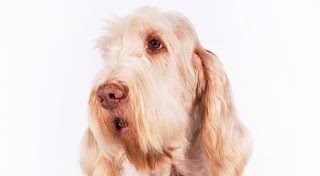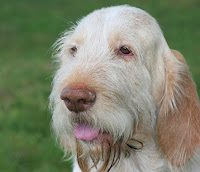AKC group: Sporting
UKC group: Gun Dog Breeds
Average lifespan: 10 to 12 years
Average size: 61 to 85 pounds
Coat appearance: Dense, Thick, and Wire
Coloration: Acceptable variants are solid white, white with orange markings, orange roan with or without orange markings, white with brown markings, and brown roan with or without brown markings.
Hypoallergenic: No
Best Suited For: Families with children, active singles, houses with yards, hunters
Temperament: Gentle, docile, loyal, friendly
Comparable Breeds: German Wirehaired Pointer
History
The breed is believed to have been developed in the Piedmont region of Italy. As the Spinone is a very ancient breed , it is not known exactly what the origins of the breed are; there are many different theories. Some of these claim that the Spinone could have originated in Italy, France, Spain, Russia, Greece, or Celtic Ireland.
Some people familiar with the history of the breed claim that the Spinone descended from the now-extinct Spanish Pointer, whilst others claim that it was the ancient Russian Setter that is responsible for the breed we know today. An even more popular theory is that Greek traders brought coarse-haired setters to Italy during the height of the Roman empire, where the dogs were then crossed with various others and the modern Spinone eventually emerged.
 |
In his Camera degli Sposi (15th century),
Andrea Mantegna depicts a Spinone,
Rubino, as a symbol of loyalty. |
The French claim that the Spinone has descended from crosses of several French pointing breeds, whilst the Italians believe the Spinone is the ancestor of the Wirehaired Pointing Griffon, the German Wirehaired Pointer, and the Pudelpointer. Any one of these claims could be true; perhaps several of them are correct.
During the Second World War, the Spinone became close to extinct. Both the war and the fact that Italian hunters had begun using other breeds in the hunt, whereas before it was primarily the Spinone. Many breeders had to resort to crossing the Spinone with other wire-haired breeds, such as the Boulet, Wirehaired Pointing Griffon and German Wirehaired Pointer.
The breed was not officially known as “Spinone” until the early 19th century. Before then, some areas knew the breed as the “Spinoso”. The breed may have been named after an Italian thorn bush, the spino, which was a favorite hiding place for small game because for larger animals it was practically impenetrable. Only thick-skinned, coarse-haired animals could fight through the branches unharmed to locate the game. The Spinone was the breed most capable of doing so, and, perhaps, therefore the name was formed.
Today the Bracco Italiano is the most popular hunting dog in Italy, although the Spinone is still common. The Bracco is a racier, higher energy dog, while the Spinone excels at hunting close or in dense cover, and in retrieving from water.
The Duchess of Northumberland has a spinone, called Fuzzy.
As puppies, Spinone Italianos are rowdy, rambunctious and full of energy. As adults, they mature into quiet, dignified companions who generally make themselves seen and not heard. They are reserved around strangers, but come to life in the outdoors. Spinones are sturdy hunting companions and make excellent hiking and jogging buddies. They get alone well with children, when raised alongside the little ones and don’t mind other family dogs. For families who have experience with dogs and love the outdoors, Spinone Italianos make excellent pets.
Health
The Spinone Italiano, which has an average lifespan of 12 to 14 years, is susceptible to major health concerns such as canine hip dysplasia (CHD), and minor issues like otitis externa, ectropion, cerebellar ataxia, and gastric torsion. Allergies and elbow dysplasia may also be seen on occasion in these dogs. Routine hip exams are recommended as the dogs grow older.
Care
Brushing and combing the Italiano is important, and occasional hand-stripping helps to clear the feet and face of dirt. The breed is adaptable to both temperate and cold weather. Regular exercise in the form of running or long hours of walking is essential for the Italiano breed. It also loves to spend time with its human family.
Content within a fenced yard, this large dog is nevertheless capable of jumping very high. The occasional one is a tunneler. Talk to breeders about secure fencing.
Trainability
For experienced trainers, Spinones are fairly easy to train. They are not dominant or overbearing, but can be quite stubborn. Novice trainers may grow frustrated or be inclined to resort to harsh treatment or discipline – which is the wrong approach to training this breed. Spinones need strong, consistent leadership but should never be punished or physically corrected, as this will cause them to shut down and become even more resistant to training and boundaries.
Spinones are reserved dogs who need extensive socialization as puppies to help them come out of their shells. If not properly introduced to new people, new situations and other animals, a Spinone can be very difficult to live with. When properly socialized, he may still be cautious around strangers, but will always be polite and dignified.
Activity Requirements
Spinone Italianos need a lot of vigorous exercise to remain healthy, happy and even-tempered. They are built for hunting and can withstand harsh terrain, hours in the sun and sopping wet conditions. Couch potatoes should not consider this breed, as they are much better suited for hunters and people who enjoy the outdoors. In the hunting field Spinones are versatile, tracking pointing and retrieving on land and water. When not hunting, Spinones enjoy walking, jogging and long hikes.
Spinones are far to large and need too much exercise to be cooped up in an apartment. These are country dogs who need plenty of room to run, roam, romp and whenever possible, to swim.
The Spinone has a dense, wiry coat that resists weather and protects him from brush and debris. As he has no undercoat, he needs only occasional brushing and hand stripping to remove dead hair. For stripping your Spinone’s coat, you can use either a stripping knife or your bare hands. Your breeder can show you proper technique, and how to tell how much hair needs to be stripped. Because of his harsh coat, he will only need a bath if he gets into something really gross.
You may want to keep a hand towel close by when your Spinone gets a drink, because afterward his beard will drip water all over the place.
Keep your Spinone’s ears clean and dry, and trim his nails and brush his teeth regularly with a vet-approved pet toothpaste. Good dental hygiene promotes general health and will also give your Spinone good breath. Start grooming him at an early age so he becomes used to the process and accepts it willingly.
Is the Spinone Italiano the Right Breed for you?
Low Maintenance: Infrequent grooming is required to maintain upkeep. Occasional trimming or stripping needed.
Minimal Shedding: Recommended for owners who do not want to deal with hair in their cars and homes.
Moderately Easy Training: The Spinone Italiano is average when it comes to training. Results will come gradually.
Fairly Active: It will need regular exercise to maintain its fitness. Trips to the dog park are a great idea.
Good with Kids: This is a suitable breed for kids and is known to be playful, energetic, and affectionate around them.
Did You Know?
The Spinone is a versatile Italian pointing breed with stamina and patience. He excels at hunting on any terrain, including being an excellent retriever, but given enough exercise can be perfectly happy as a companion dog.







